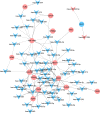Screening for Regulatory Network of miRNA-Inflammation, Oxidative Stress and Prognosis-Related mRNA in Acute Myocardial Infarction: An in silico and Validation Study
- PMID: 35210840
- PMCID: PMC8863347
- DOI: 10.2147/IJGM.S354359
Screening for Regulatory Network of miRNA-Inflammation, Oxidative Stress and Prognosis-Related mRNA in Acute Myocardial Infarction: An in silico and Validation Study
Abstract
Background: Acute myocardial infarction (AMI), which commonly leads to heart failure, is among the leading causes of mortality worldwide. The aim of this study was to find potential regulatory network for miRNA-inflammation, oxidative stress and prognosis-related mRNA to uncover molecular mechanisms of AMI.
Methods: The expression profiles of miRNA and mRNA in the blood samples from AMI patients were downloaded from the Gene Expression Omnibus (GEO) dataset for differential expression analysis. Weighted gene co-expression network analysis (WGCNA) was used to further identify important mRNAs. The negatively regulatory network construction of miRNA-inflammation, oxidative stress and prognosis-related mRNAs was performed, followed by protein-protein interaction (PPI) and functional analysis of mRNAs.
Results: A total of three pairs of negatively regulatory network of miRNA-inflammation and prognosis-related mRNAs (hsa-miR-636/hsa-miR-491-3p/hsa-miR-188-5p/hsa-miR-188-3p-AQP9, hsa-miR-518a-3p-C5AR1 and hsa-miR-509-3-5p/hsa-miR-127-5p-PLAUR), two pairs of negatively regulatory network of miRNA-oxidative stress and prognosis-related mRNAs (hsa-miR-604-TLR4 and hsa-miR-139-5p-CXCL1) and three pairs of negatively regulatory network of miRNA-inflammation, oxidative stress and prognosis-related mRNA (hsa-miR-634/hsa-miR-591-TLR2, hsa-miR-938-NFKBIA and hsa-miR-520h/hsa-miR-450b-3p-ADM) were identified. In the KEGG analysis, some signaling pathways were identified, such as complement and coagulation cascades, pathogenic Escherichia coli infection, chemokine signaling pathway and cytokine-cytokine receptor interaction and Toll-like receptor signaling pathway.
Conclusion: Identified negatively regulatory network of miRNA-inflammation/oxidative stress and prognosis-related mRNA may be involved in the process of AMI. Those inflammation/oxidative stress and prognosis-related mRNAs may be diagnostic and prognostic biomarkers for AMI.
Keywords: acute myocardial infarction; inflammation; mRNAs; miRNAs; oxidative stress; prognosis.
© 2022 Yin et al.
Conflict of interest statement
The authors report no conflicts of interest in this work.
Figures









Similar articles
-
Identification of circRNA-miRNA-Immune-Related mRNA Regulatory Network in Gastric Cancer.Front Oncol. 2022 Feb 24;12:816884. doi: 10.3389/fonc.2022.816884. eCollection 2022. Front Oncol. 2022. PMID: 35280778 Free PMC article.
-
Screening and Analysis of Potential Critical Gene in Acute Myocardial Infarction Based on a miRNA-mRNA Regulatory Network.Int J Gen Med. 2022 Mar 10;15:2847-2860. doi: 10.2147/IJGM.S354641. eCollection 2022. Int J Gen Med. 2022. PMID: 35300139 Free PMC article.
-
Construction and Bioinformatics Analysis of circRNA-miRNA-mRNA Network in Acute Myocardial Infarction.Front Genet. 2022 Mar 29;13:854993. doi: 10.3389/fgene.2022.854993. eCollection 2022. Front Genet. 2022. PMID: 35422846 Free PMC article.
-
Construction of miRNA-mRNA network reveals crucial miRNAs and genes in acute myocardial infarction.J Biomed Res. 2021 Oct 10;35(6):425-435. doi: 10.7555/JBR.35.20210088. J Biomed Res. 2021. PMID: 34857679 Free PMC article.
-
The Role of CTNNA1 in Malignancies: An Updated Review.J Cancer. 2023 Jan 1;14(2):219-230. doi: 10.7150/jca.79236. eCollection 2023. J Cancer. 2023. PMID: 36741258 Free PMC article. Review.
Cited by
-
Early diagnosis of acute myocardial infarction via hub genes identified by integrated weighted gene co-expression network analysis.Am Heart J Plus. 2025 Jun 10;56:100554. doi: 10.1016/j.ahjo.2025.100554. eCollection 2025 Aug. Am Heart J Plus. 2025. PMID: 40575177 Free PMC article.
-
Profiles and interactions of gut microbiome and intestinal microRNAs in pediatric Crohn's disease.mSystems. 2024 Sep 17;9(9):e0078324. doi: 10.1128/msystems.00783-24. Epub 2024 Aug 16. mSystems. 2024. PMID: 39150251 Free PMC article.
-
Identification of oxidative stress-related genes and potential mechanisms in atherosclerosis.Front Genet. 2023 Jan 4;13:998954. doi: 10.3389/fgene.2022.998954. eCollection 2022. Front Genet. 2023. PMID: 36685865 Free PMC article.
-
Identification of immune-related biomarkers co-occurring in acute ischemic stroke and acute myocardial infarction.Front Neurol. 2023 Aug 17;14:1207795. doi: 10.3389/fneur.2023.1207795. eCollection 2023. Front Neurol. 2023. PMID: 37662030 Free PMC article.
-
Integration of RNA molecules data with prior-knowledge driven Joint Deep Semi-Negative Matrix Factorization for heart failure study.Front Genet. 2022 Oct 10;13:967363. doi: 10.3389/fgene.2022.967363. eCollection 2022. Front Genet. 2022. PMID: 36299595 Free PMC article.
References
LinkOut - more resources
Full Text Sources

